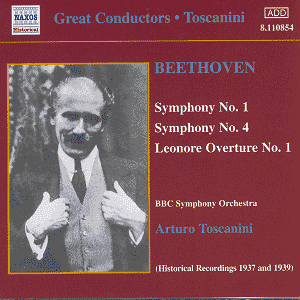Between 1935 and 1939 Arturo Toscanini paid no
less than five visits to London to give concerts and make recordings
with the BBC Symphony Orchestra. This was a considerable feather
in the cap of this young orchestra and its founder/trainer, Dr
Adrian Boult. The present recordings were made during the second
and the last of those visits. The story of Toscaniniís relationship
with the orchestra is related in more detail in Ian Julierís very
good notes.
The performance of the delightful, effervescent
First Symphony is a very fine one. It opens with a dignified
reading of the introduction to the first movement. This is marred
very slightly by some imprecise chording but thatís the last blemish
on the BBC orchestraís playing. Toscanini draws some excellent
legato lines out of the players. The main body of the movement
is genial but energetic. Itís a joyful affair, just as it should
be. Comparing it with the exactly contemporaneous Vienna account
by Felix Weingartner (also on Naxos) I found that Toscanini was
a little more wont to relax though not to the detriment of the
flow of the musical argument. He also observes the exposition
repeat, which I like. The BBC orchestraís playing is excellent
and very responsive. Indeed, comparing these readings with Toscaniniís
1951 recordings of the same works I found that throughout both
this performance and that of the Fourth symphony the BBC players
did not suffer at all in comparison with the playing of the NBC
Symphony. I say this bearing in mind that the NBCSO was a band
which Toscanini knew much better
The andante is beautifully played with affectionate
phrasing. Again Toscanini observes the exposition repeat; something
he didnít do in 1951. I found the phrasing smoother than in the
Weingartner recording and preferred Toscaniniís version for that
reason. In 1951 his adopted speed is just a little less relaxed;
I prefer the 1937 reading. The Menuetto is light on its feet,
featuring nimble and dextrous playing from the BBC SO. By contrast
the 1951 remake is a bit more deliberate and I prefer the lighter
touch of the earlier reading. The finale opens wonderfully. The
slow introduction lasts a mere 33 seconds here but in that short
space of time Toscanini conjures up a marvellous sense of anticipation,
even more than he achieved in 1951. This is great conducting.
The main allegro scampers along like quicksilver, displaying a
real kinship with the finale of Mozartís ĎJupiterí symphony. In
short, this is a very fine reading. I like the 1951 version very
much but, on balance, I think the earlier account is even more
convincing and Iím delighted that itís available.
The Fourth Symphony begins with a lengthy
introduction and here Toscanini imparts a real sense of mystery
and tension. The main allegro, in which the repeat is omitted,
goes at a tremendous lick. It sounds joyful and exuberant, not
driven. The BBC players respond enthusiastically. Itís noticeable
how closely Toscanini observes Beethovenís many dynamic markings
and just how much energy is released as a direct result. This
is a clear case of respect for the score producing the best results.
The slow movement is not one of Beethovenís best,
in my opinion. However, once again Toscanini ensures that it is
played with scrupulous attention to detail; there is some fine
work by the woodwind principals. The difficult scherzo (Beethovenís
hardest?) is played with real panache. There is excellent ensemble
in the ebullient and difficult finale - special credit here to
the scurrying strings. Again, I thought this was a pretty marvellous
performance.
The disc is rounded off with a splendid, dramatic
reading of the Leonora Overture No. 1. This was recorded
on the same day as the Fourth Symphony. The performances of these
two pieces took place only a few days after Toscanini had guided
the orchestra through a thrilling reading of the Missa Solemnis
(available on BBC Legends). Clearly conductor and orchestra were
on vintage form at this time.
In an accompanying note Mark Obert-Thorn points
out that the transfer of the Fourth Symphony was particularly
problematical because the original recording of the last few minutes
was sonically compromised even when it was issued. The sound in
the last two or three minutes of the finale is less bright, the
detail is less clear and the bass is more boomy. However, the
deterioration in sound quality is fairly slight and I doubt that
it will inhibit enjoyment. What the note also demonstrates is
the tremendous effort Mr. Obert-Thorn has made to secure an acceptable
transfer. Pre-war Victor pressings were used. He combined the
best sides from four different copies of the First symphony, six
of the overture and no less than seven of the Fourth symphony.
All this effort for a CD selling at super budget price!!
Suffice it to say that the engineerís skill has
not been wasted. What we have here is a very fine set of performances
which show why Arturo Toscanini was such a great conductor. To
be able to achieve such results with an orchestra with which he
did not work regularly is remarkable indeed, the more so when
one recalls that the orchestra had only been established a few
years before. What a tribute the playing is also to Boultís training!
To be asked to pay £5 or the equivalent for such
vital, engaging examples of re-creative musicmaking is as absurd
as it is generous. I hope that there will be more such issues
including other material recorded during Toscaniniís London visits.
In the meantime, bravo Toscanini, bravo BBC SO, bravo Naxos! Strongly
recommended.
John Quinn
see also review
by Tim Mahon
